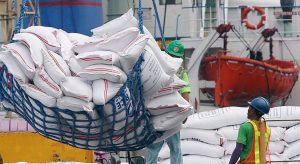THE US Department of Agriculture (USDA) said it raised its Philippine rice import forecast for marketing year 2023-2024 to 4.7 million metric tons (MMT) from 4.6 MMT estimated a month earlier.
In its Grain: World Markets and Trade report, the USDA said the updated estimate is now in line with its rice import projection for the 2024-2025 marketing year.
“The Philippines is a major consumer of rice and, in recent years, has become the largest rice importer with recent policy changes spurring additional imports,” the USDA said.
In June, President Ferdinand R. Marcos, Jr. signed Executive Order (EO) No. 62 which lowered the tariff on imported rice to 15% from 35% until 2028. The new tariff regime is subject to review every four months.
The EO is expected to reduce the retail price of rice by P6 to P7 per kilogram, according to the Department of Agriculture (DA).
“Lower tariffs are expected to decrease landed prices, easing inflationary pressures while spurring additional Filipino rice consumption,” the DA added.
The USDA said the new estimate was spurred by stronger than expected import volumes during the first six months of 2024.
Rice imports amounted to 2.32 MMT during the six months to June, according to the Bureau of Plant Industry (BPI), citing totals as of July 4.
In the year earlier period, rice imports were 1.86 MMT.
The Agriculture department is projecting rice imports of 3.9 MMT this year.
The USDA added that importers have shifted some purchases to other countries due to rising global rice prices and tighter supply from Vietnam.
In January, the Philippine and Vietnamese governments signed an agreement giving the Philippines a quota of 1.5 MMT to 2 MMT of rice annually for five years.
Shipments from Vietnam have totaled 1.72 MMT, followed by Thailand with 352,331 MT.
The USDA said that the increased import volumes have resulted “in closer connectivity between international and Philippine rice prices.”
A kilogram of imported well milled rice sold for between P51-P55 in Metro Manila markets, while regular-milled rice fetched P46-51 per kilo, according to DA price monitors as of July 11.
Asked to comment, Ateneo de Manila economist Leonardo A. Lanzona said that lifting of the Indian government’s ban on rice exports may drive the Philippines to import more.
“With the lifting of India’s ban, the probability of even higher imports seems more certain,” Mr. Lanzona said via Messenger chat.
“As the agricultural sector continues to face hurdles due to weather conditions, the government has instituted a tariff policy designed in favor of consumers,” he added.
Last year, India banned the exports of non-basmati white rice due to domestic supply concerns. Imports from India was estimated at 21,701 MT, the BPI said.
In October, the Indian government gave the Philippines an export quota of 295,000 MT for non-basmati white rice.
The USDA said that due to the ban on Indian rice exports, the Philippines leaned more heavily on suppliers Vietnam and Thailand, pushing up their export prices.
“Buyers in the Philippines chose to pay these elevated prices from Southeast Asian suppliers, which resulted in higher retail prices in the Philippines,” it added.
Former Agriculture Undersecretary Fermin D. Adriano said that with the lowering of tariffs, imported rice will become cheaper than its domestic equivalent.
However, he added that traders may delay their imports until the Supreme Court (SC) decides on a farmer petition for a temporary restraining order (TRO) against EO 62.
“Importers will hedge over importing rice for as long as TRO issue is not settled because they will lose money,” Mr. Adriano said in a Viber message. — Adrian H. Halili
